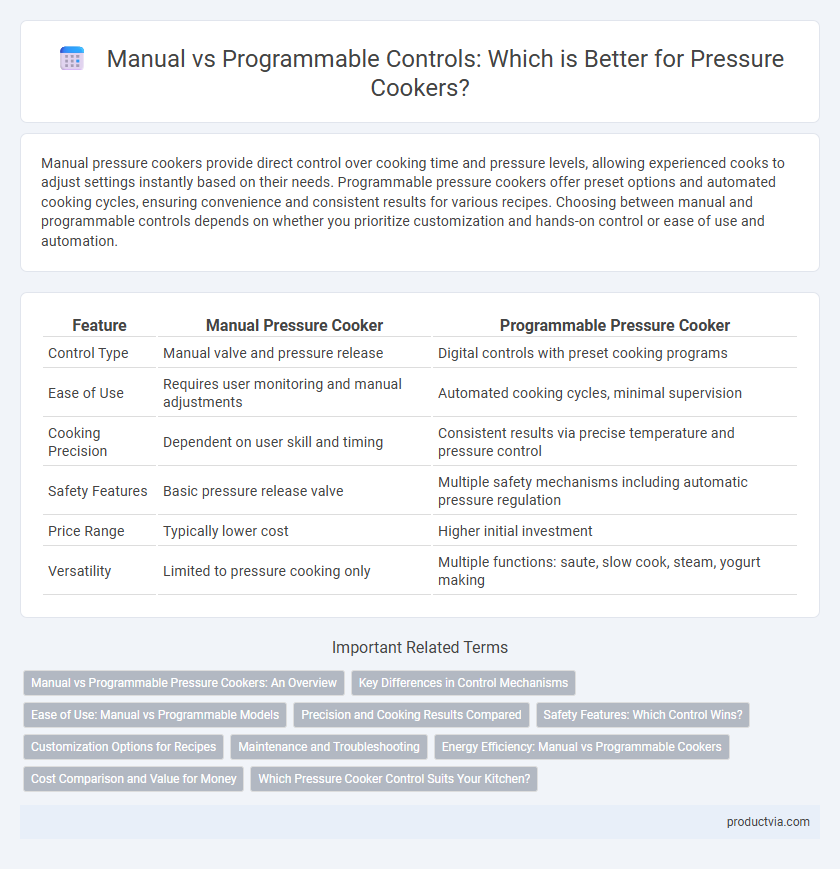Manual pressure cookers provide direct control over cooking time and pressure levels, allowing experienced cooks to adjust settings instantly based on their needs. Programmable pressure cookers offer preset options and automated cooking cycles, ensuring convenience and consistent results for various recipes. Choosing between manual and programmable controls depends on whether you prioritize customization and hands-on control or ease of use and automation.
Table of Comparison
| Feature | Manual Pressure Cooker | Programmable Pressure Cooker |
|---|---|---|
| Control Type | Manual valve and pressure release | Digital controls with preset cooking programs |
| Ease of Use | Requires user monitoring and manual adjustments | Automated cooking cycles, minimal supervision |
| Cooking Precision | Dependent on user skill and timing | Consistent results via precise temperature and pressure control |
| Safety Features | Basic pressure release valve | Multiple safety mechanisms including automatic pressure regulation |
| Price Range | Typically lower cost | Higher initial investment |
| Versatility | Limited to pressure cooking only | Multiple functions: saute, slow cook, steam, yogurt making |
Manual vs Programmable Pressure Cookers: An Overview
Manual pressure cookers require constant user monitoring to adjust heat and cooking time, offering straightforward control and typically lower cost. Programmable pressure cookers feature digital interfaces with preset cooking programs, timers, and pressure control, enhancing convenience and precision. Choosing between manual and programmable models depends on user preference for hands-on operation versus automated cooking flexibility.
Key Differences in Control Mechanisms
Manual pressure cookers require users to regulate cooking time and pressure by adjusting stove heat and monitoring pressure indicators, offering direct control but demanding constant attention. Programmable pressure cookers utilize microprocessor-based controls to automate pressure levels, cooking times, and temperature settings, ensuring consistent results with minimal supervision. The key difference lies in manual models relying on user input for pressure management, while programmable models provide pre-set or customizable cooking programs for convenience and precision.
Ease of Use: Manual vs Programmable Models
Manual pressure cookers offer straightforward operation with simple pressure control mechanisms, making them ideal for users who prefer hands-on cooking and direct control over cooking time and pressure levels. Programmable pressure cookers provide preset cooking programs and digital interfaces, simplifying meal preparation through automated settings that adjust temperature and pressure for different recipes. Ease of use favors programmable models for beginners or busy cooks seeking convenience, while manual models appeal to experienced users valuing tactile feedback and precise manual adjustments.
Precision and Cooking Results Compared
Manual pressure cookers allow direct control over cooking time and pressure, enabling experienced users to customize settings for precise results. Programmable pressure cookers feature preset functions and sensors that automatically adjust pressure and cooking duration, ensuring consistent and reliable outcomes with less user input. The programmable models typically provide better precision for complex recipes, while manual cookers offer flexibility favored by traditional cooks.
Safety Features: Which Control Wins?
Manual pressure cooker controls rely on user vigilance and traditional safety mechanisms such as weighted pressure valves and pressure indicators, offering simplicity but requiring careful attention to prevent accidents. Programmable pressure cookers incorporate advanced safety features including automatic pressure regulation, electronic temperature control, and multiple built-in safety locks that minimize risks and enhance operational precision. The programmable control wins in safety due to its ability to actively monitor and adjust cooking conditions, significantly reducing the chance of user error or hazardous pressure build-up.
Customization Options for Recipes
Manual pressure cookers offer precise control over cooking time and pressure, allowing users to tailor settings based on specific recipes and ingredient types. Programmable pressure cookers feature preset modes but often include customizable parameters such as temperature, pressure level, and cooking duration for greater recipe flexibility. Both types support recipe adaptation, but programmable models provide enhanced convenience through digital interfaces and memory functions.
Maintenance and Troubleshooting
Manual pressure cookers feature straightforward controls with minimal electronic components, making maintenance easier and troubleshooting more intuitive for users. Programmable pressure cookers incorporate complex microprocessors and sensors that require specialized knowledge and tools for diagnostics and repairs. Regular inspection of seals and valves and adherence to manufacturer guidelines are crucial for both types to ensure safety and optimal performance.
Energy Efficiency: Manual vs Programmable Cookers
Manual pressure cookers rely on user control for temperature and time, often leading to variable energy consumption depending on cooking habits. Programmable pressure cookers optimize energy efficiency by automating precise pressure, temperature, and timing adjustments, minimizing energy waste. Studies indicate programmable models reduce energy use by up to 20% compared to manual cookers through optimized cooking cycles.
Cost Comparison and Value for Money
Manual pressure cookers typically cost less upfront due to their simple design and fewer electronic components, making them budget-friendly for basic cooking needs. Programmable pressure cookers offer advanced features like customizable cooking settings and timers, often justifying their higher price with greater convenience and precision. Evaluating value for money depends on user priorities: manual models excel in durability and affordability, while programmable models provide enhanced functionality that can save time and improve meal quality.
Which Pressure Cooker Control Suits Your Kitchen?
Manual pressure cookers offer precise control over cooking time and pressure by adjusting the heat source, making them ideal for experienced cooks who prefer hands-on operation. Programmable pressure cookers feature digital controls with preset cooking programs, providing convenience and consistent results, perfect for busy kitchens and beginners. Choosing between manual and programmable pressure cooker control depends on your cooking style, level of experience, and how much automation suits your kitchen routine.
Manual vs Programmable for Pressure Cooker Control Infographic

 productvia.com
productvia.com